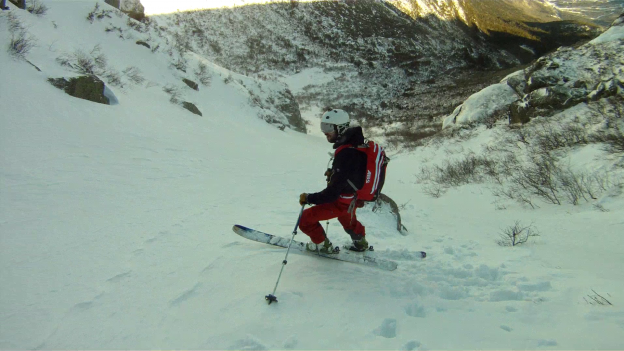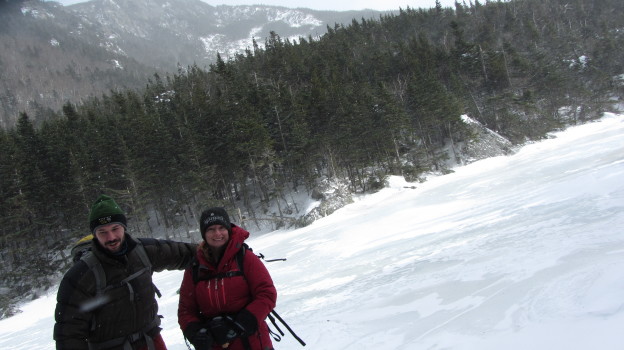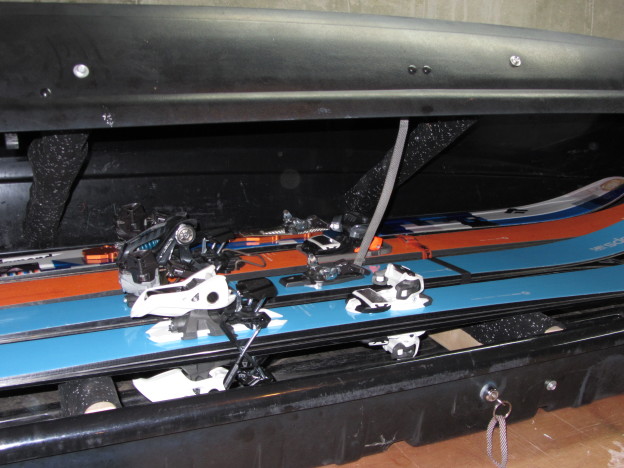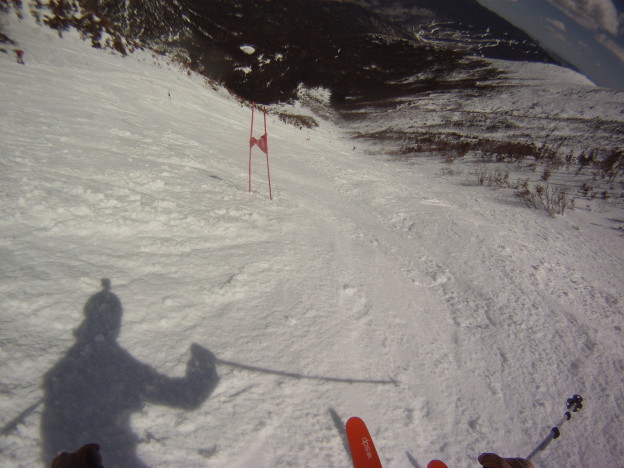It’s never too late for more video! Finally an edit from my first post-Dynafiddle excursion in which literally nothing went wrong and we had a nice day. Check it out:
Gear List:

It’s never too late for more video! Finally an edit from my first post-Dynafiddle excursion in which literally nothing went wrong and we had a nice day. Check it out:
Gear List:

After seeing the promising early season snowpack decimated by the Christmas rain event, Kelly and I opted to skip the resort scene and head out for a light winter hike. Now that we’re committed to a backcountry Montana excursion, some extra conditioning certainly couldn’t hurt. An arctic front was firmly entrenched in the Whites for New Years weekend, bringing with it bitter cold and blustery conditions. Not wishing to repeat our desperate scree-scramble atop Mt. Washington amid gale force winds, we selected a route substantially below treeline: Carter Notch via 19 Mile Brook Trail.
The hike is an 8 mile round trip, out and back. It ascends gently for the first 3 – 3.5 miles, where it briefly climbs over the shoulder of the Wildcat ridge before dipping down in to the Notch. The notch is a pretty spectacular spot: the precipitously steep east flank of the Wildcat Ridge tumbles into two alpine ponds nestled at the bottom of the even steeper Carter Dome. Even though it’s not the majestic summit of some craggy peak, Carter Notch is a worthy day hike destination.
Since we were theoretically trying condition ourselves for the Montana trip, I loaded my 65 L pack up with all sorts of indulgent paraphernalia: puffy pants, a down jacket, down mitts, extra gloves, my shell, a fleece vest, microspikes, crampons, an ice ax, some camera equipment, you get the idea – way more stuff than you need for a low angle, sub-tree-line, day hike. I also brought along my new flexible tripod to experiment with concocting some creative shots in the wilderness. Have a look!
Gear List:

Before Winter 14-15 gets into gear (which seemingly won’t be for a while as of this writing) a couple of nagging issues have to be addressed with our adventure mobile. Firstly, the second generation Xterra in it’s factory configuration tends to bottom out when hauling ass over big potholes and rough roads. No fun when riding to or from the mountains exhausted at 10:30 PM. And second, the infamous Thule tried to sabotage my new carbon fiber skis last winter and such behavior wouldn’t be tolerated again!
The solution to the suspension was simple, however it’s worth giving some backstory. The suspension itself isn’t really bottoming out. I have new aftermarket struts and they seem to have plenty of life in them. After Googling around a bit I discovered that I’m not the first person to complain of this problem (read here and here, or just do some more Googling).
It turns out that the real issue is that there is just not very much clearance between the frame and axle. The factory bumpstops (hunks of rubber which prevent the frame from bouncing directly on the axle) are really firm and frequently collide with the axle giving the passengers a good jolt. One of the suggested solutions (and in my case the least invasive) was to replace the factory bumpstops with an aftermarket set designed to offer progressive resistance, stiffening the ride a bit and smoothing big jolts. You can read more about the solution here and find a solution for your own SUV here. It’s theoretically a simple install, involving only a few wrenches and some bolts, but after many New England winters my undercarriage was so ornery that it needed a professional touch.
The Thule required a bit more engineering. At some point last season my brand new DPS Wailer 99s rattled around in the roof box enough to severely damage one of the tips. After a good deal of staring at my crummy old second-hand Thule Mountaineer, drawing, speculating, measuring and theorizing, we devised a plan. And then we scrapped the original plan and did something else altogether.
The requirements were simple: we had to be able to easily toss at least 4 pairs of skis into the box in such a way that they would not shift around in transit. Thule and other have already solved this problem with their flat top style carriers, but I’ve never liked the idea of sandblasting your skis for 2 – 4 hours while en route to the mountain.
The solution was something of a hybrid between the flat tops and the existing box: we fashioned a set of bars which would mount inside the box and clamp down on 4 pairs of skis when closed. The obvious trade off is that only 4 pairs of skis can ride up top now. Seems like a fair trade off for peace of mind and longevity of equipment. Here’s a run down of the action:

Bolting the bottom braces into the Thule. We placed two bolts on the bottom and one on each side. The sides were strangely shaped, so shims were cut to size and wedged into place to consume the extra space.

Notice that the rubber mats are bolted on the sides of the lumber so that the bolts don’t contact the skis.

Finished product with some big skis, for show. Also, notice the top rails. Those are 2″x4″s ripped in half and wrapped in the same rubber mat material. These are simply bolted on each end.

Last April, on a whim, Kelly and I signed up for the Tuckerman Inferno. For those unacquainted, the Inferno is a pentathlon with solo categories, two-man team and five-man team categories. We entered as duo. I would lead off with an 8+ mile run (with over 400 feet of hill climbing). Kelly would take the second leg, navigating down the only recently thawed Saco River for 6+ miles, after which she would transition to the bike leg: 18 miles, nearly entirely uphill for a whopping 2000′ feet of climbing. At Pinkham Notch Kelly would tag me and I’d set off on the last two stages of the race, the trail run, followed by the ski race. The trail run consists of about 2000′ of hiking via the Tuckerman Ravine Trail, before a transition to ski gear for the final 800′ or so of climbing before skiing back down to Pinkham. Check out the full course map, below.
But before all of that, we had to get all the gear and the people in the right spots. The logistics were less than straightforward. After much debate, we settled on a plan. We talked Shane into loaning us his Jeep for the day. Kelly would load her bike into his car, and drop it at the kayak-bike transition before proceeding to the run-kayak transition where should stash the key and wait for me to arrive on foot to start her first leg of the race. Meanwhile, I would take the Xterra, with our 14′ kayak, to the kayak launch, and drag the kayak over the snow for about half a mile to river. Following that, I’d drive to the race start, and park for the run. Upon completing the run and tagging Kelly, I’d go find Shane’s car, and drive it back to the race start, retrieve my own car, and drive to Pinkham to wait for Kelly to bike in. Kelly’s bike would be conveniently waiting for her at the transition, she’d arrive in Pinkham via bike and at the end of the race we’d drive the Xterra back to town, recover the kayak and Shane’s car and roll back to Denaro’s house for some serious napping. Easy, right?
After squaring away all of the aforementioned logistics, I settled in at the start area and started getting my my head in gear for the run. This consisted mostly of trying not to think about any of what was about to go on. The last time I ran 8 miles was probably in high school, and the most amount of running I’d done any time recently was a measly 4 mile jaunt down the pancake flat Minuteman Bike Trail out our front door. For that training attempt I ran in my Merrell Chameleon trail sneakers, and determined that they were way too stiff and heavy to do any serious running in. For the race, I opted for my Merrell Trail Glove ultra-light trail running shoes. To my surprise, I actually settled into a great pace and was able to hold my position all the way uphill for the first 4 miles of the race. The downhill, however was my downfall. My legs, which were conditioned for distance running, did not much care for the whole business of charging downhill for 4 straight miles in minimalist trail sneakers with virtually not cushion or support. By the time I stumbled into the icy transition area by the Saco River, my knees were in full revolt, and I had lost maybe a half-dozen places during the descent, typically something which I would have considered a strong area.
Either way, Kelly got off to a good start on the Kayak leg, and I staggered back to the parking area in search of Shane’s car. Unbeknownst to me, while I was fumbling with Shane’s low-on-battery-key fob and driving North on Route 16, Kelly was getting into a royal adventure on the frothing white water of the Saco. Apparently, just minutes after putting into the water, a fellow racer, forced her to take a sub-optimal line through a stretch of rapids, causing her to go under a low hanging falling tree. Unable to adequately limbo the tree, she was pulled out of her boat, breaking her paddle in the process. I honestly have no idea how she managed to retrieve the kayak, and the paddle, and climb out of the river with 3′ high snow banks on either side after taking a full body dunk in 32.5 degree water, but somehow she accomplished all this, before running back to the run-kayak transition in search of a new paddle. The course officials were unable to help, but a by stander informed her that he might have an extra paddle in his truck back in the parking area across the street. What luck! All she had to do was run across the street, find this guy’s truck, get the paddle, ran back to the river across knee deep snow and ice, and then back down the bank where the kayak was stashed, to continue the race. Honestly I might have given up. After all of this she managed not to be the last one out of the water, and in fact went on to make up significant lost time during the bike segment.
The bike segment starts with a mile or so of warmup, followed by an unrelenting ascent of the biggest hill I’d ever run up (the bike and run had some overlap), and a hairy 40 mph descent of said hill. After that brief respite from climbing, the bike route climbs steadily for miles all the way to Pinkham Notch. There was a lot of low gear action, from what I understand.
After the run leg, I drove up to the bike-hike transition, dropped my gear and then went in search of parking. I strolled back to the transition with just some food and water and made myself comfortable in the late morning sun. The bike-hike transition area was a fairly hilarious scene, as athletes rolled through, either done for the day, or heading onto the next leg of their race. I bore witness to all manner of exhaustion-produced profanity and mishap as racers swapped gear and started the second to last leg. By the time Kelly arrived, I was starting to worry that something had gone awry, but was expecting it to be more along the lines of how unspeakably arduous 18 miles of hill climbing on a bicycle is (that’s what pretty much all the rest of the bikers had to say upon arriving in the transition area). Instead she told me that the climb was brutal, but that she had been passing people the entire way up, and the real trouble came during the kayak leg. Finding myself inspired by her heroics on the Saco, I grabbed my gear and ran out of the transition area at at totally unsustainable pace.
After a few minutes, I settled into a speed-hike which I maintained for most of the rest of the hike. For the hike I wore my Merrell Chameleon’s with microspikes, and carried my skis, boots and helmet with my lightweight TNF resort bag, along with a hydration pack. I took 2-3 quick breathers but otherwise held a steady pace, making it from the Deritissma Parking lot to the foot of Hillman’s Highway in about an hour and a quarter. From there I switched to my AT boots for the final push to the top of the GS course. My transition was outright terrible. After both of the legs cramped up, I spent like 10 minutes getting into my boots, which are ordinarily slippers compared to normal alpine boots. I slogged up the well established booter to the top of the course and geared up for the final effort of the day. I spent maybe another 5 minutes messing with gear and catching my breath at the top of the course.
The ski run is unfortunately the only leg of the race where we were able to capture footage of any sort. We were supposed to have mounted a GoPro to Kelly’s kayak helmet, though in hindsight it may be better that I forgot to – God only knows what would have happened when she capsized under a tree… Any way, here are some unique stills from the downhill portion of the Inferno.
I have to admit that by the time I was skiing, my legs were totally shot. I took more than a few quick breathers on the way down the mountain – not quite what I was hoping, but my legs were threatening to strike, and I had to acquiesce. Maybe half an hour later, I straggled through the finish area, where Kelly was waiting. She helped me drag my gear back to the parking area and rounded up Xterrible, before we headed over to Wildcat for the award ceremony and some apres-race beers.
We finished toward the back of the pack, as seen in the results here, but I would argue not too badly given the kayaking mishap, and overall lack of preparation. Taking a closer look at the results, we can see that our transitions really killed us. Kelly’s kayak to bike transition was a full 10 minutes. That would have bumped us up one spot alone. I’m certain I wasted valuable time during my own transitions as well. It’s difficult to imagine a savings there pulling us up to the next rung, but if we subtract one kayak fiasco, maybe… O well there’s always next year!
Gear List: